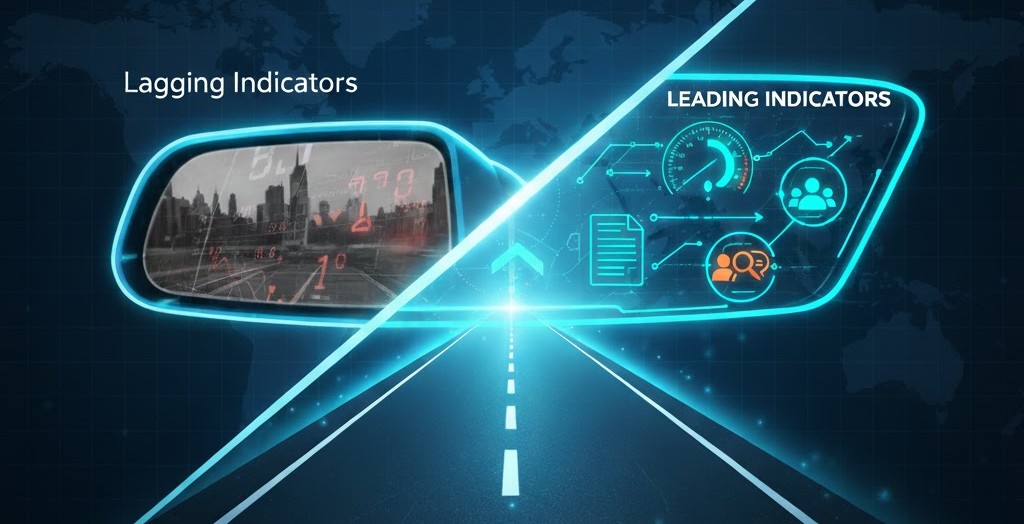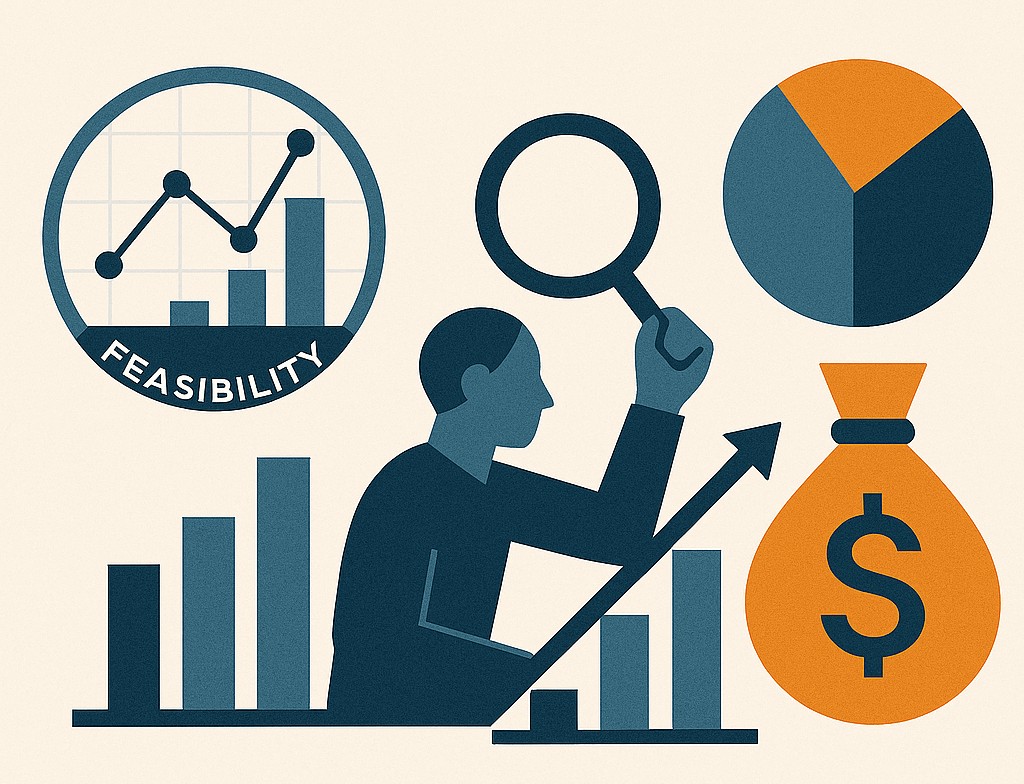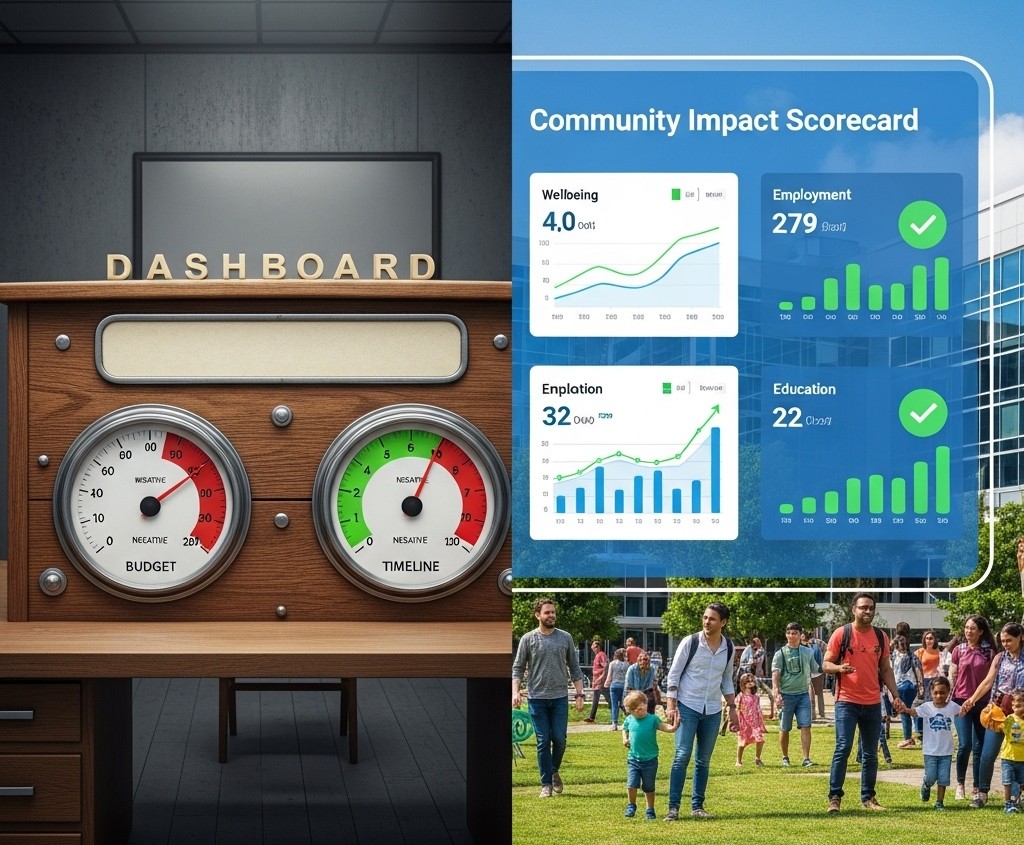Analytics & Data Mining


Most monthly Business Reviews share a fatal flaw: they are autopsies, not interventions.
Executives spend hours dissecting financial variance, budget actuals, and past output. While critical, these are lagging indicators. They are the rear-view mirror—telling you exactly where you’ve been, but offering no help with the curve ahead. By the time these numbers hit your dashboard, the outcome is already sealed.
To actually drive performance, you need to look through the windshield. You need leading indicators.
These are the "upstream" operational metrics that act as early warning systems. A sudden spike in casework backlogs today predicts service delays next month. Declining stakeholder engagement signals policy resistance ahead. Rising front-line overtime forecasts burnout and error rates long before the official audit helps you find them.
Lagging indicators confirm your history; leading indicators secure your future.
Review your dashboard today. If it’s 90% historical data, you aren't managing performance—you're just reporting on it. Find the upstream signals that allow you to intervene before the result is set in stone.

You're drowning in data. New dashboards, KPIs, and reports arrive daily, each promising 'deeper insights'. Yet, most of this data deluge isn't insight—it's noise. More metrics don't equal more clarity; they often just obscure the vital few.
Before you invest time or resources in tracking another new metric, pause and apply this simple 3-question filter. It's the executive's framework for separating high-value signals from low-value 'vanity data'.
1. The Action Test: If this metric moves up or down, what specific action will we take? If the answer is "we'll just monitor it" or "we're not sure," the metric fails. Data that doesn't trigger action is an academic exercise.
2. The Decision Test: What specific, high-stakes decision does this metric inform? Does it help you make a critical trade-off (e.g., invest in X vs. Y)? If it doesn't anchor a key decision, it's not pulling its weight.
3. The Clarity Test: Is this the simplest, most direct way to measure the outcome we care about? Or is it a complex, lagging indicator that just adds clutter?
Don’t celebrate more data: demand better decisions. Use these questions to cut through the noise.

In today's complex and increasingly volatile landscape, risk is an ever-present factor. From market fluctuations to geopolitical uncertainty and operational disruptions, organisations face a myriad of potential challenges that can derail even the most carefully planned initiatives.
Traditional risk assessment relies on historical data and qualitative judgment, which, while useful, can fall short in anticipating unprecedented events or understanding dynamic interdependencies.
This is where analytics and simulation-based approaches prove to be transformative risk management instruments. By leveraging sophisticated models and computational techniques, organisations can move beyond simple forecasting to create dynamic" what-if" scenarios. Monte Carlo simulations, for instance, allow organisations to model thousands of potential outcomes based on varying inputs and probabilities, providing a comprehensive view of potential risks and their likelihood.
These tools assist organisations to identify vulnerabilities, quantify potential losses, and evaluate the effectiveness of different mitigation strategies. Whether assessing supply chain fragility, pricing volatility, or project timelines, analytics and simulation offer deeper insights, leading to more informed decision-making and a more resilient operational framework.
Embracing these advanced techniques is no longer just an advantage – it’s a necessity for robust and forward-looking risk management.

Every significant initiative, whether a major infrastructure project or a transformative policy change, begins as an idea. But how do we bridge the gap between a compelling concept and a funded reality? The answer lies in rigorous, data-driven analysis.
Securing stakeholder buy-in and substantial funding requires more than just a powerful vision. Decision-makers, investors, and funders demand a clear, defensible business case. This is where robust economic and financial analysis becomes indispensable. Methodologies like Cost-Benefit Analysis (CBA) provide the evidence needed to quantify value, assess viability, and forecast tangible outcomes. They move the conversation from "we think" to "we can demonstrate."
For private enterprises, this analysis underpins sound capital investment. For government agencies, it's the cornerstone of responsible public resource allocation, ensuring taxpayer funds generate the greatest community benefit. A well-constructed analytical framework not only justifies the initial outlay but also provides a roadmap for measuring success.
Ultimately, solid analytics is not just a compliance hurdle; it is the strategic foundation that transforms ambitious proposals into successful, impactful realities, providing the confidence needed to invest wisely

Here are four essentials to make your cost-benefit analysis (CBA) as solid and robust as possible:
1. A Clear "Do-Nothing" Baseline A CBA should always include a "do-nothing" or "business-as-usual" scenario. This allows you to evaluate only the incremental costs and benefits of the proposed project, ensuring your analysis isn't skewed by changes that would have occurred anyway.
2. Document assumptions transparently Outline every rate, price and behavioural assumption in the appendix. Make your discount rate and inflation forecast explicit so readers can trace your logic—and challenge it where needed.
3. Balance quantitative and qualitative factors Pair hard metrics (NPV, ROI) with qualitative benefits like stakeholder trust or social impact. A well-rounded CBA acknowledges benefits that defy precise dollar values but still move the needle.
4. Include Sensitivity and Risk Analysis Incorporate sensitivity analysis to test how the outcome change sunder different assumptions. By stress-testing key variables, you’re not only gauging the resilience of your findings, you’re also identifying potential risks.

When delivering a program on the scale of Building Homes for NSW, metrics on time, cost and number of dwellings built – while essential – only tell part of the story. A program designed to change lives should be measured by its impact on lives.
Forward-thinking housing authorities are developing sophisticated performance scorecards that balance financial and delivery metrics with key social outcomes. This includes tracking tenant stability, improvements in education and employment, reduced interaction with the justice system, and healthcare cost avoidance. Implementing such a framework not only provides a richer narrative of success but also enables active performance management, allowing agencies to direct resources to the models and partners who are delivering the greatest public good.

Is it that the machines are getting smarter … or that people are getting dumber?
(Yes America: I’m looking at you).
We’re worried that the machines might become self-aware.
Are we completely sure that, umm, people are self-aware?
Oh, and Yes: the accompanying picture was generated by a machine.

- Analyse web-captured free text customer feedback to source good news stories and identify areas of risk or dissatisfaction
- Analyse KPI results to determine which KPIs drive others, and which are lead indicators; use this to go behind traffic light indicators to unpack the *drivers* of performance
- Benchmark offices or service outlets against each other to find best/worst performers; use this as a prompt to find the sources of high performance
- Derive regional or area structure based on spatial distribution of clients
- Derive whole-of-life cost estimates for hard assets/infrastructure. Model the impact on asset condition of various maintenance regimes over the expected life of the asset
- Check for irregularities to supplement exception reporting and assure probity of accounts payable processes for internal audit, Auditor-General etc.

- Analytics techniques can be used to 𝑠𝑖𝑚𝑢𝑙𝑎𝑡𝑒 𝑎𝑛𝑑 𝑝𝑟𝑒𝑑𝑖𝑐𝑡 𝑡ℎ𝑒 𝑟𝑎𝑛𝑔𝑒 𝑜𝑓 𝑝𝑜𝑠𝑠𝑖𝑏𝑙𝑒 𝑜𝑢𝑡𝑐𝑜𝑚𝑒𝑠 𝑓𝑜𝑟 𝑝𝑟𝑜𝑝𝑒𝑟𝑡𝑦 𝑑𝑒𝑣𝑒𝑙𝑜𝑝𝑚𝑒𝑛𝑡𝑠 𝑜𝑟 𝑙𝑎𝑛𝑑 𝑟𝑒𝑐𝑙𝑎𝑚𝑎𝑡𝑖𝑜𝑛 𝑒𝑓𝑓𝑜𝑟𝑡𝑠
- Asset and facility managers can use analytics to model maintenance expenditure to 𝑠𝑡𝑟𝑖𝑘𝑒 𝑡ℎ𝑒 𝑏𝑒𝑠𝑡 𝑏𝑎𝑙𝑎𝑛𝑐𝑒 𝑜𝑓 𝑚𝑎𝑖𝑛𝑡𝑒𝑛𝑎𝑛𝑐𝑒 𝑐𝑜𝑠𝑡 𝑣𝑖𝑠-à-𝑣𝑖𝑠 𝑎𝑠𝑠𝑒𝑡 𝑐𝑜𝑛𝑑𝑖𝑡𝑖𝑜𝑛 𝑜𝑣𝑒𝑟 𝑡𝑖𝑚𝑒
- Where large-scaled, detailed data for a given property market is available, analytics can be used to sift through the array of property attributes to potentially 𝑖𝑑𝑒𝑛𝑡𝑖𝑓𝑦 𝑢𝑛𝑑𝑒𝑟-𝑣𝑎𝑙𝑢𝑒𝑑 𝑝𝑟𝑜𝑝𝑒𝑟𝑡𝑖𝑒𝑠
- For owners with multiple holdings, analytics can be used to help 𝑚𝑎𝑘𝑒 ‘𝑠𝑒𝑙𝑙-𝑣𝑒𝑟𝑠𝑢𝑠-𝑟𝑒𝑡𝑎𝑖𝑛’ 𝑑𝑒𝑐𝑖𝑠𝑖𝑜𝑛𝑠
- Analytics techniques can be used to 𝑠𝑒𝑔𝑚𝑒𝑛𝑡 𝑏𝑢𝑦𝑒𝑟 𝑚𝑎𝑟𝑘𝑒𝑡𝑠 to break them down into discrete groups 𝑡𝑜 𝑤ℎ𝑖𝑐ℎ 𝑡𝑎𝑟𝑔𝑒𝑡𝑒𝑑 𝑎𝑝𝑝𝑟𝑜𝑎𝑐ℎ𝑒𝑠 𝑐𝑎𝑛 𝑏𝑒 𝑚𝑎𝑑𝑒 𝑏𝑦 𝑣𝑒𝑛𝑑𝑜𝑟𝑠 𝑜𝑟 𝑡ℎ𝑒𝑖𝑟 𝑎𝑔𝑒𝑛𝑡𝑠.

